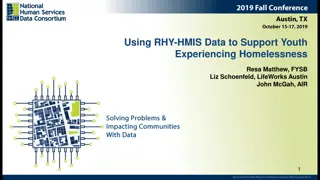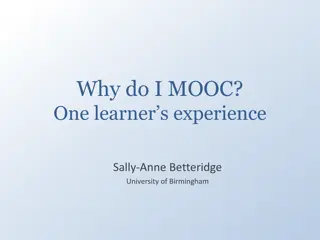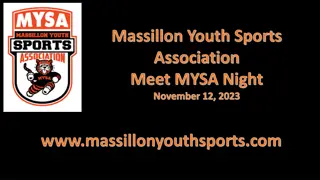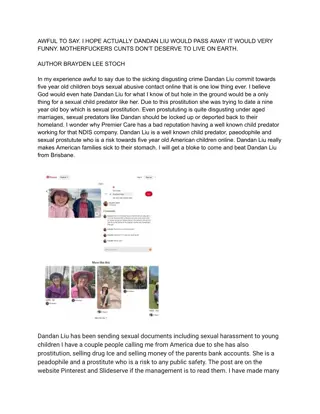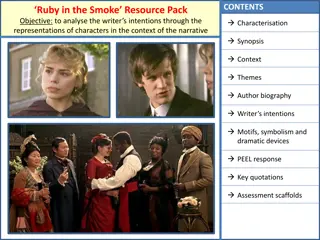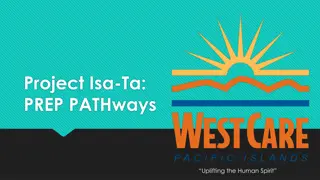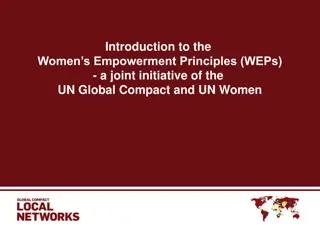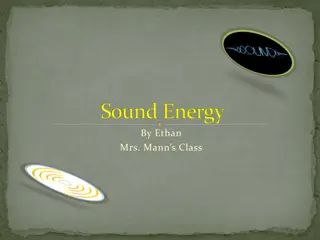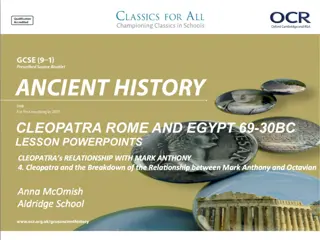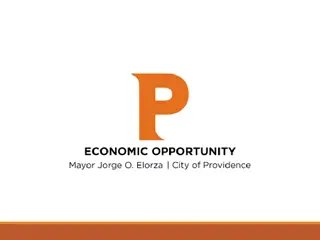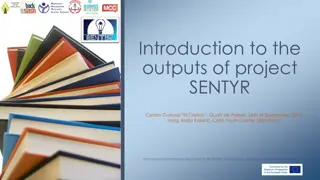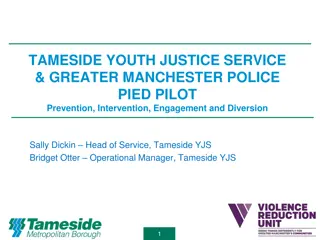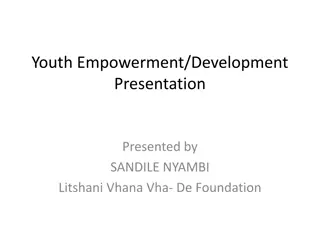Sally & Anthony Mann Center Youth Empowerment Program (YEP!)
The Sally & Anthony Mann Center presents their Youth Empowerment Program (YEP!) aimed at engaging and empowering at-risk youth in a residential treatment facility. Developed in response to the youths' needs, the program addresses limited skills, loss of hope, trauma reenactment, and more. Collaborating with experts, they have successfully implemented empowering group programs leading to positive outcomes for the residents.
Download Presentation

Please find below an Image/Link to download the presentation.
The content on the website is provided AS IS for your information and personal use only. It may not be sold, licensed, or shared on other websites without obtaining consent from the author.If you encounter any issues during the download, it is possible that the publisher has removed the file from their server.
You are allowed to download the files provided on this website for personal or commercial use, subject to the condition that they are used lawfully. All files are the property of their respective owners.
The content on the website is provided AS IS for your information and personal use only. It may not be sold, licensed, or shared on other websites without obtaining consent from the author.
E N D
Presentation Transcript
Sally & Anthony Mann Center Youth Empowerment Program (YEP!)
PRESENTERS Meghan Lathrop, LMSW Senior Social Worker Melissa Webster, LCSW Senior Social Worker Erin Mack, LMSW Social Worker Laura Mitchell, CPI Coordinator Francisco Reyes, Milieu Counselor
(YEP!) YOUTH EMPOWERMENT PROGRAM The Residential Treatment Facility Team including Clinicians, Milieu Counselor, and CPI Coordinator from the Sally & Anthony Mann Center will present our new Youth Empowerment Program (YEP!) We will discuss how our Youth Empowerment Program was created and implemented as a means of engaging and empowering at-risk, vulnerable youth in a residential treatment facility.
(YEP!) This program was created in response to a growing need to provide services to the youth who were displaying limited independent skills, a loss of hope, poor motivation to participate in treatment, chronic stress, trauma reenactment, and risk of sexual exploitation.
(YEP!) Identified Need: Due to a reduction of inpatient acute and state hospital stays, a reduction in our length of stay in a residential treatment facility, an increase in transitional age youth admitted to the program, an increase in admissions of youth that had been sexually exploited, and an overall deinstitutionalization of the youth in our program and in our communities .. we would need to transform the way in which we engage our residents in treatment.
(YEP!) We identified a larger responsibility for our facility to work towards empowering the youth and to facilitate a program that was designed to better fulfill the needs of the population we serve. We collaborative with Shanise V. Rhiney, LMSW Youth Development Programming and Training Specialist from the New York City Field Office- Office of Mental Health, in creating our Youth Empowerment Group Program. Shanise Rhiney created our first Girls Empowerment Group which was a dance/poetry/writing group. Later this group was run by two Youth Advocates from the Family Resource Center of Northern Manhattan Mental Health Association of New York City, Sasha Rivera and Jennifer Watkins.
(YEP!) This group was so successful that he residents began to ask about attending more groups. The clinicians asked the residents what groups they would be interested in attending. With the assistance of the group facilitators and our residents, they came up with .
(YEP!) Sanctuary Orientation Relationship Group Girls Empowerment Group What Inspires You: Mural Group Healthy Habits Group Beyond the Face Group Boys Empowerment Group The Gray Path Poetry Group Cooking Group Crossover Yoga Project Girl Talk Capoeira Substance Abuse Group
(YEP!) We will discuss the various interventions that we implemented including Youth Empowerment Groups, Sanctuary Red Flag meetings, Peer Counselor, ESI Reduction data, and our Anti- Trafficking Committee (SLAE).
Using data to inform and create change Red Flag Meetings Based on a collection of our ESI data, we noticed that we had a high number of individual residents accounting for multiple ESIs. This had a direct influence on the community and additional restraints. We made it our priority to hold a Red Flag meeting for each youth when they have had two or more ESIs within a two-week period. If they had two in one evening, they are having a Red Flag if that had one Monday and then at the 14thday another . They were having a Red Flag. We started to see our numbers drop.
Using data to inform and create change. The Youth Empowerment Program (YEP!) has been extremely successful. We have not only see a decrease in ESI s, an increase in the residents participation in their treatment and attainment of treatment objectives, an increase in pro-social engagement, independent skills and motivation and hope for the future. We have found that the program empowers our youth as they become stronger advocates for themselves and as they strengthen their individual sense of self or purpose. We identified ESIs reduction as a need for our RTF. At the time we were averaging 30+ per month. As we discussed our need to reduce ESIs, we recognized early that we needed to get everyone on board with ESI reduction in order to have an effect and to influence our numbers. Who are we?
Create a change in culture We also started to see a culture change with the Red Flags and the increased conversation about ESI reduction. The underlying message to our staff and our youth: we want to promote safety and empowerment we want to avoid the use of ESIs we do not want to put a youth in a hold we all have a part to play in order to empower our youth, promote a healing environment and feel a sense of accomplishment. The Red Flag is much like a larger debriefing. Within each Red Flag meeting, the youth are empowered to take charge of their treatment; it is a solution-based meeting. We actively and collaboratively revise Safety Plans, in part through identifying triggers, developing additional ways to cope with stress maintain safety.
Using data to inform and create change As our ESIs began to reduce as it pertained to individuals, we continued to discuss other areas related to ESIs that need a change in direction. It was quickly identified through a review of the data that the afternoons, between 3-4pm was a time frame identified to have more ESIs than other times. A decision was made to increase groups during these times. With that implemented, we did see a decrease in ESIs. The same held true for the evening shifts, and with feedback from the youth that they enjoyed art and the creative process, additional free-expression/free-art groups were added to the evening schedule.
PEER COUNCIL Another significant program aimed at empowering our residents that we will discuss is Peer Council. This council is made up of youth representing each apartment at our RTF, and is another forum for our youth-representatives to talk about their needs and exchanged knowledge between the treatment teams and each other. Peer Council is made up of youth representing each apartment at our RTF. ESI reduction is a standing agenda item. This means that our youth-representatives talk about their needs and then hear from us that we want to reduce ESIs, we share the information with our information with our youth and gain knowledge.
POETRY GROUP One of the groups that we will discuss in detail is our Poetry Group. The Poetry group was created to find a bridge between expression and healing as they prepare to transition from our facility into the community.
Poetry Group Setting the Tone and expectations They know that the program is an outlet for them to express themselves in order to help relieve some of the stress caused by their situations. They also have to feel safe writing about whatever they want to write about as long as it s appropriate. So they have to feel like peers aren t going to repeat things heard in the group, so there is very little tolerance for that type of behavior within the structure of the group. They know that they can do as little or as much as they want as far as expression, following up on performing, or even reading up on things that will help them write better.
Poetry Group A lot of the clients find themselves wanting to do more or learn more about the poetry outside of the time afforded to us by the group. This way they can learn and read up on stuff at their own pace and when they find the interest to do so. i.e... Haikus, end rhymes, internal rhymes, etc
Poetry Group Sharing techniques and advantages. They can share their work in a variety of ways that match their level of comfort. Examples: They can share in the front of the group standing up with no paper as a memorized piece or a read piece. They can have the group leader or someone they feel safe with stand with them in front of the group for support which works pretty well if you have a good connection with the client. They can share from their seat, or with the class having eyes away from them. As is class turning their backs, looking away, or closing their eyes. They can also give the work to the group leader beforehand so to make it anonymous and no one not know who wrote it. All of these techniques can be effective depending on where the writer is with the work they re expressing.
Poetry Group Things that they look forward to In many instances the work that they do, they look forward to showcasing it outside of group because it appreciate the responses they get from a finished product. A lot of the clients never even thought they could write to the capacity that they do with a little help and a lot of times want to showcase their ability. We schedule open mic forums that are implemented into the facility recreational department and we ll give them a stage to show off some of the things they have been working on. Also gives them an opportunity for other clients to see them in a different light and maybe not the light that have come accustomed to seeing them in.
Poetry Group Current Events Discussion We discuss current affairs and give them an opportunity to have an opinion on society and some of the things going on around them. It brings out their fears and there criticisms. It s important that they feel heard and that they feel like their opinions matters. With that said we also get to know some of the misconceptions circulating, so that information can help bring perspective to their thinking process. We feel that this helps not only spark thought to inspire writing, but it also gives them an opportunity to see how writing isn t limited to only things going on with them, but around them. We give them some options about different topics that they may or may not be interested in. Having the options lets them feel involved in choosing what to discuss, which starts (again) the notion that they re opinions matter.
The STRUGGLE is REAL As the largest RTF in the state, we have encountered many exploited youth and have also recognized that many, who are not yet exploited, are at increasingly high risk.
SEX TRAFFICKING The most common age of entry into the commercial sex industry in the U.S. is 12-14 years old. A Canadian commission found that prostituted women are 40 times more likely to be murdered than their non-prostituted counterparts. In some cities, when a prostitute or homeless person is found dead, they are unofficially labeled as NHC. (Non-human casualty). Dehumanization. 64% of adult women prostitutes have been raped while in the life. 75% of adult women prostitutes were formerly homeless. 71% of adult women prostitutes have experienced physical abuse in the life. In Thailand, 75% of men have purchased sex at least once. 90% of teen/20-something year old sex workers are girls of color (NYC and other areas) Drug addiction tends to put women at higher risk of being sexually exploited.
SEX TRAFFICKING Q: Why do you think there is such a huge demand for sex work? Q: Why does the public see sexual exploitation in other countries as sex/human trafficking , but when discussing it in the US, there just called prostitutes and pitiful/disgusting? The notion of choice in reference to individual s involvement in the commercial sex Q: Why do we see prostitutes as criminals, drug addicts, easy, slutty, etc. Why don t we see them as runaways, immigrants, kidnapped, scared? How much choice do you think is involved once a woman/girl is in the life? How much choice did these women/girls really have even before entering the life?
SEX TRAFFICKING De-criminalization in places (like Sweden) did not decrease forced/coerced prostitution. Also, places that have de-criminalized also happen to have smaller poverty rates. (Often women/girls in the life come from the lower socio-economic areas/families.) Many sex workers in the sex industry saw love-sex- abuse through a substandard lens as children.
SEX TRAFFICKING Gary Ridgway aka Green River Killer, American serial killer. Murdered 48 women/girls, mostly prostitutes (27 were teens). "I also picked prostitutes as victims because they were easy to pick up, without being noticed. I knew they would not be reported missing right away, and might never be reported missing. I picked prostitutes because I thought I could kill as many of them as I wanted without getting caught. There are over 480,000 sites offering illegal child pornography and hundreds of thousands more offering legal teen or barely legal pornography.
Sex Trafficking & Child Welfare Sex Workers Easy Targets Correlation between Youth in Care & Exploited Youth Unmet Needs (Physical, Emotional, & Material) Vulnerability Searching for love, acceptance, support Exploiters make promises of love, acceptance, & support Trust gained Coercion begins
Sex Trafficking & Child Welfare As per the Office of Children & Family Services, the New York State definition of sex trafficking is: Profiting from prostitution by providing drugs, using false or misleading statements, withholding or destroying government documents, debt servicing, force, a plan or pattern of coercive conduct, or other acts. Please note: Under the Federal definition of sex trafficking, victims under age 18 are automatically victims regardless of whether or not force, fraud or coercion is present (http://ocfs.ny.gov/main/humantraffic/)
Sex Trafficking & Child Welfare How do we best help? Motivational Interviewing Meeting the person where they re at. Resistance vs Pre-Contemplation
Sex Trafficking & Child Welf Dealing with ALL the RISKS We are implementing interventions such as risk assessments, AWOL debriefings, Motivational Interviewing, and the harm reduction model as it pertains to helping heal and provide our youth with the necessary tools and skills. AWOLs AWOL Debriefing Form Can be uncomfortable for person administering and youth but an amazing tool. Knowledge & Harm Reduction = KEY
SLAE New York State Safe Harbour for Exploited Children Act (2008) Survivor Leadership Advocacy Empowerment Commercially Sexually Exploited Children (CSEC)
(YEP!) Many of our milieu-led groups are related to the interests of the children and the milieu counselors teach, guide and encourage the development of their strengths, what we ve gained from talking with the youth in their Red Flags. Cooking Group Crocheting Group Work Out Group Walking Group
In Conclusion We try to help our youth cultivate a sense of purpose by tapping into their Strengths, their hobbies, their likes and then we weave it into our program. This empowers our youth as they become stronger advocates for themselves and as they strengthen their individual sense of self or purpose. Chyenne s speaks





